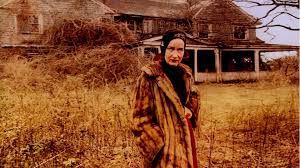I’m sitting at my desk watching Grey Gardens.
This is not a coincidence, but it’s not related to class prep or to the recent death of co-director Albert Maysles.
Instead, it’s a refresher before I urge you to take a trip to see the 40th anniversary restoration of Grey Gardens playing for one week starting tomorrow.
This is one of Albert and David Maysles’s most famous films. The 1976 documentary, shot in their customary direct cinema style (“fly on the wall”), positions the filmmakers as observers while Big Edie Beale and her daughter Little Edie Beale tell their life stories from the dilapidated mansion in East Hampton that they called home for 50 years.
Eccentric may be a mild word to describe the two women bound by blood and history but isolated from most other people and the larger world outside their own grey garden.
Big Edie and Little Edie came into public consciousness in the early 1970s when reporters discovered that the two women, cousins of Jacqueline Kennedy Onassis, were facing eviction from their home after government inspections deemed it a hazard to public health.
Onassis and her sister Lee Radziwill provided funds to bring the mansion up to code, but the condition of the home and the lifestyle of the mother and daughter are still disturbing to watch. For me, the film is as sad as it is fascinating.
Did Big Edie and Little Edie really understand the implications of having the filmmakers in their private spaces (interior and exterior)? It doesn’t seem so.
The ethics of the film have been debated, but what is not up for debate is the important place the film holds in cinema history.
Two of the Maysles’s Brothers 30-plus films have been named to the Library of Congress’s National Film Registry. Grey Gardens is one of them, and the other is my personal favorite, Salesman from 1968.
